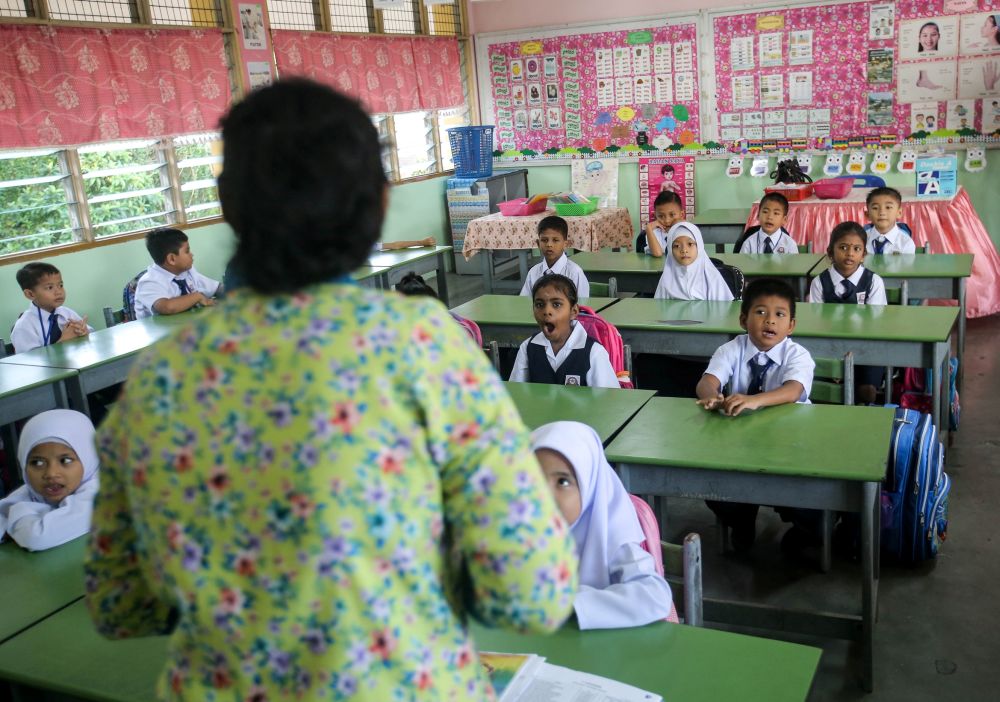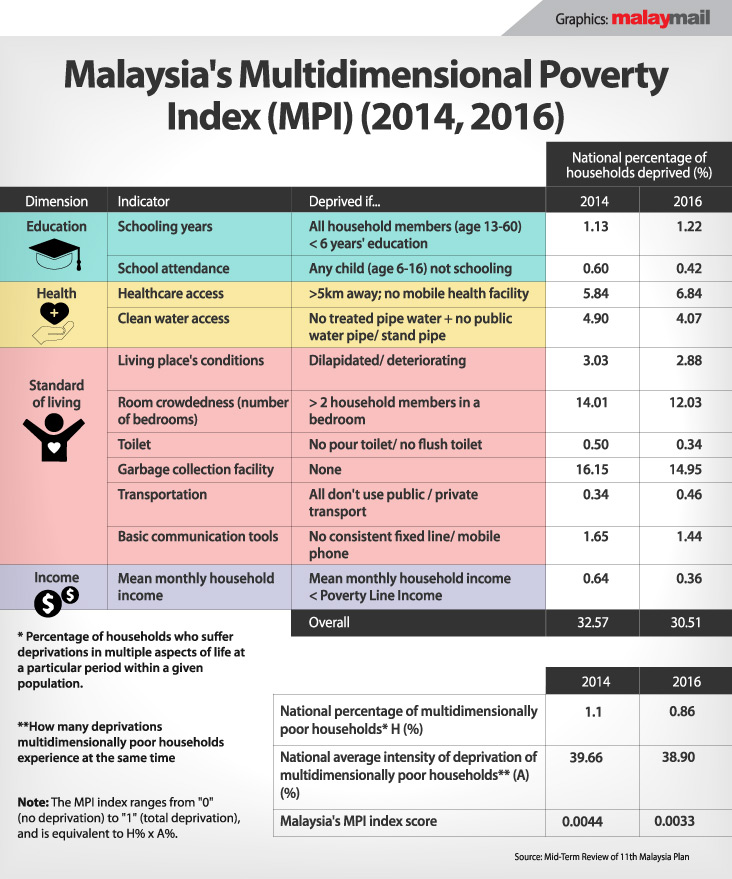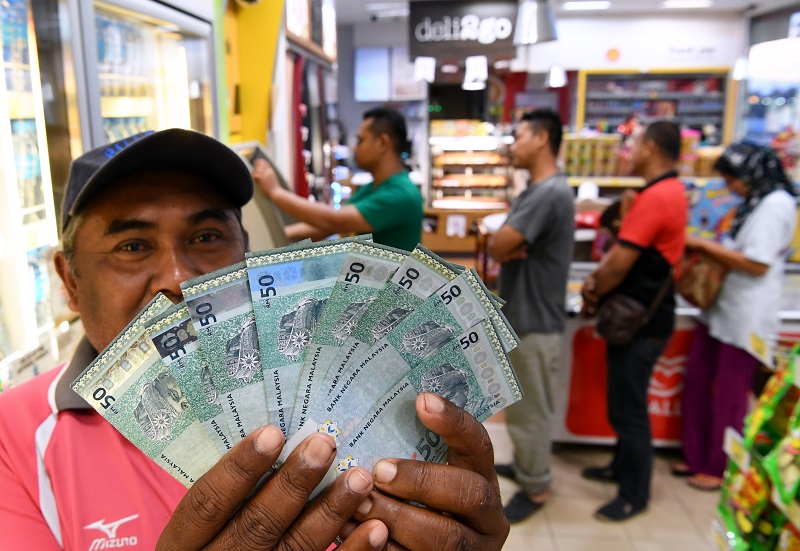KUALA LUMPUR, Sept 6 — Experts say Malaysia can do better in how it measures how many Malaysians are officially considered poor by using higher benchmarks to match its current status as an upper middle-income nation.
When it comes to measuring poverty levels in Malaysia, the government currently uses two methods: Poverty Line Income (PLI) and the Multidimensional Poverty Index (MPI).
Before going further into how Malaysia can have more accurate measures of poverty, here’s a quick explanation of PLI and MPI:
1. Poverty Line Income (PLI)
The Ministry of Economic Affairs recently said the PLI — which is used to measure “absolute poverty” — is based on a household’s basic requirements to live healthily and actively.
Malaysia currently uses a PLI level of RM980 nationally, and at a higher level of RM1,020 for Sarawak and RM1,180 for Sabah (to factor in additional costs such as transportation costs), the ministry had said. (The RM980 monthly PLI would translate to slightly above RM8 per person daily based on a household of four.)
(In 2014, the PLI was RM930 for Peninsular Malaysia, RM990 for Sarawak and RM1,170 for Sabah.)
Households with monthly incomes below the PLI level are considered poor, which means there are officially 24,700 households (or a mere 0.4 per cent of total households) in Malaysia that are categorised as poor as of 2016.
Experts have said however that the PLI needs to be raised to present a more accurate indication of the poverty levels in Malaysia.
Jeffrey Sachs Centre on Sustainable Development research associate Derek Kok said Malaysia is currently an upper middle-income country and should at least set its benchmarks against other countries in the same income bracket, and not use lower-income countries as the benchmark.
“A lot of the government’s welfare and social assistance policies now already focus on B40 instead of just those below the defined poverty line — this is an implicit admittance that the poverty line is too low,” he told Malay Mail.
World Bank senior economist Kenneth Simler said the current PLI of US$1.90 (RM7.97) per person per day — under the World Bank’s standard for extreme poverty and United Nations’ Sustainable Development Goal (SDG) — is not suited as reference for Malaysia’s PLI benchmark, which should be higher.
“So for SDG purposes, Malaysia uses that, that’s appropriate across all countries in the world for extreme poverty. But it’s not really the PLI you want to use for developing domestic policies here,” he told Malay Mail.

A higher poverty line does not mean poverty is on the rise
Having previously cited economist Prof Martin Ravallion as saying that Malaysia’s PLI should be increased by almost three times, Simler explained that there would be more people falling below a higher PLI level but this does not mean an increase in poverty levels.
“And that’s not the case, what you are doing is you are recognising what before you considered not poor, really, is poor in the current conditions,” he said, adding that Malaysia’s poverty levels will still be shown to have decreased over the past decades even with the PLI updated to match improved living standards in the country.
“It’s not that poverty has increased, it’s just that the benchmark has not kept pace with the change of [income and quality of life] in Malaysia and it’s time to upgrade it.
“Maybe people are living above what the minimum level of well-being was considered in 1970, but not at a level that is considered at least a minimum acceptable level for 2019.”

2. Multidimensional Poverty Index (MPI)
Many countries have now recognised that it is not enough to measure poverty by looking at how much a household earns, and are now measuring other ways where one may experience poverty.
The Oxford Poverty and Human Development Initiative (OPHI) had in 2010 developed the MPI with the support of the United Nations Development Programme (UNDP), with the tool measuring acute poverty via deprivations suffered in the areas of health, education and living standards.
Malaysia in 2013 joined a global network of countries that adopted the MPI tool to measure poverty, and had launched its own customised MPI in 2015 through the country’s latest five-year development blueprint—the 11th Malaysia Plan (2016-2020).
In the 11th Malaysia Plan, the government had among other things said it would introduce the MPI to measure vulnerability and quality of life besides income, saying it would enable clear identification of the needs of lower-income households and broader policy considerations.
Below is Malaysia’s MPI model, which uses data collected by the Department of Statistics Malaysia on Malaysian households to measure poverty from four dimensions of health, education, standard of living and income.
(This is the latest version which was tabled in Parliament in October 2018 as part of the government’s Mid-Term Review of the 11th Malaysia Plan):
 Based on the MPI benchmarks used by Malaysia, the official findings in 2014 showed only 1.1 per cent of total households nationwide were “multidimensionally poor” or facing deprivations in multiple aspects of life.
Based on the MPI benchmarks used by Malaysia, the official findings in 2014 showed only 1.1 per cent of total households nationwide were “multidimensionally poor” or facing deprivations in multiple aspects of life.
This poverty level under MPI fell further to only 0.86 per cent of households nationwide in 2016.
Why Malaysia’s poverty measures need improvements
Citing the 2016 MPI figures which show only 0.86 per cent, Simler said this meant the poverty monitoring tool is only looking at about one per cent of the Malaysian population, which he noted was a “missed opportunity” to keep track of the impact of policies on the B40 group.
“Because the MPI now is so low it is only talking about the bottom one per cent. You could lift the income of others in the B40 and not just income, but access to education, health facilities, quality of living conditions and the current MPI will never measure that because it is only measuring the very bottom.”
Without increasing the benchmarks in the MPI, the Malaysian government would not be able to see how far it is progressing in improving living conditions for the B40, or which areas such as education or health where it is doing relatively well or not so well, he said.
He said an MPI with higher and more ambitious benchmarks would help with the monitoring of living conditions of the B40, and would allow a “more focused” approach in policies to those worst-off or most deprived within the B40.
He noted that many of the indicators used in Malaysia’s MPI show “a very low percentage of Malaysian households who are deprived by the indicator, meaning it’s a very low bar.”
“And if you looked at all those indicators, whether it is income or some of the education or health indicators, they would all be very appropriate for Malaysia 62 years ago or a low-income country today, but it is not really appropriate for Malaysia today.
“The MPI was introduced with the advent of the 11th Malaysia Plan but already the country has surpassed most of these thresholds. So you are talking about less than one per cent of the population, it doesn’t give much information or traction or information for policy purposes, and that’s ultimately what it will be used for,” he said.
He said that increasing the benchmarks for indicators in the MPI to “more ambitious, more relevant” levels would provide more information about multidimensional poverty among Malaysians, and would also be “more consistent with an upper middle-income country on the verge of becoming a high-income country.”
“We think that Malaysia’s MPI, one of the good features of it is that it includes income poverty as one of the four dimensions. In some countries, they look at income poverty on one hand, and then other dimensions in a completely separate way.
“We think the way Malaysia is combining it is actually good practice, the World Bank does it in its own multidimensional poverty measure,” he said.
“But the thing is by having the income indicator based on the PLI which only has 0.4 per cent of Malaysian households below it, basically it doesn’t tell you anything about income poverty, because everybody has already crossed that threshold, so that part of multidimensional poverty isn’t captured with such a low PLI.”
How we can do better
The World Bank’s recent research provides an illustration of how setting higher benchmarks that are more fitting with Malaysia’s current living standards may help policymakers seeking to address poverty.
In the World Bank’s presentation at last month’s 62nd ISI World Statistics Congress 2019 that was made available to Malay Mail, examples of alternative benchmarks that could be used for the 2016 MPI assessment were listed and compared against the lower benchmarks that had been used.
While the MPI used by the Malaysian government shows the percentage of households facing the respective deprivations, the World Bank’s illustration is based on calculations of the percentage of population facing deprivations.
Below is the comparison, which shows the results of figures using the World Bank’s examples and calculation method:
 By using the alternative benchmarks based on higher standards, the alternative index for 2016 shows 19.2 per cent of the population as living in households considered to be multidimensionally poor.
By using the alternative benchmarks based on higher standards, the alternative index for 2016 shows 19.2 per cent of the population as living in households considered to be multidimensionally poor.
This is higher than the poverty level of 0.86 per cent of households considered to be multidimensionally poor, based on the government’s current MPI benchmarks.
The alternative benchmarks in the World Bank’s illustration were limited by the data available in the latest available Household Income and Basic Amenities Survey, with one of the alternative examples being raising the benchmark for the number of years of schooling to lower secondary school level (nine years) instead of primary school level (six years).
Simler explained that the World Bank’s illustration used a common measure by the OECD of 50 per cent of the median monthly income, which in this case is RM621.20 per person per month for Malaysia at 2016 levels.
Simler, however, noted that the World Bank research only showed possible alternatives and was not prescribing a new set of MPI benchmarks for Malaysia, recommending that Malaysia develops its own homegrown MPI and also its higher benchmark for a PLI.
“Yes, I will be very clear on that. I think it’s in Malaysia’s hands. Because I think since what some people feel is very important in one setting or one context or one country might not be important in another context or another country. You want something that people really feel and not some artificial exercise handed to them.”
He said it is for Malaysia to decide on what indicators are important and appropriate in determining multidimensional poverty, and said this might mean collecting new data if such indicators are not already part of the ongoing 2019 Household Income Survey.
Simler said his recommendation would be for Malaysia to use both the PLI and MPI tools to measure poverty levels in the country, but with both to have higher benchmarks.
“I think the MPI is a nice enhancement, but it’s fairly new to Malaysia... So I think for the near future at least it would be good to use both,” he said.

Child poverty measures?
Jeffrey Sachs Centre on Sustainable Development’s Kok said there needs to be a rethink on how poverty is defined, and that a holistic MPI is needed to go beyond minimum standards for survival and to address the multiple deprivations that prevent an individual from living a dignified life.
“Basically the MPI needs to account for the fact that vulnerable segments of the population experience deprivations from poverty differently such as indigenous communities and children,” he said, also citing those who are disabled as an example.
“For example, what deprivations that a child faces in one family may not be the same as those faced by a child in another family with the same income and consumption level.
“At the same time, a child could face deprivations while other household members (including other children) are not affected,” he said.
Kok suggested that the MPI account for such differences by either having “child-specific indicators in the national MPI or have a standalone one.”
“So when I say child-specific indicators within the MPI, one measurement can be stunting. Why? Because stunting can affect health and education outcomes of children, which in turn may impact a child’s long-term development and their future earning potential, which impacts their socio-economic situation,” he said when explaining how this could lead to the problem of poverty being perpetuated.
Kok said child deprivation is rarely talked about in Malaysia as the issue of socio-economic welfare is usually about adults “despite the fact that poverty impacts children worse than adults”, further noting that stunting or impaired child growth rarely registers in welfare policy-making.




















